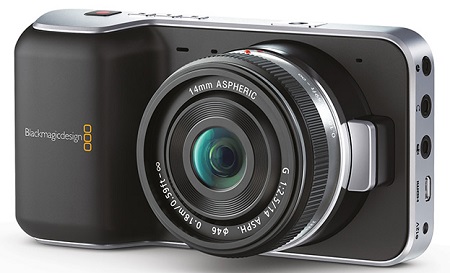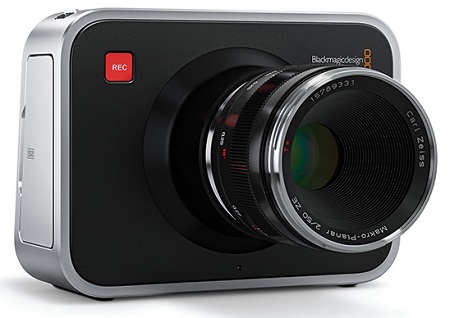The Art of Product Design: A Conversation with Dan May
ALEXANDRIA, VA. — Like many of you, I enjoy everything about new products. I linger over the way they smell and feel. I crave the way they subtly hum with vitality and promise, bringing a smile to even the most jaded industry long-timers.

Blackmagic Pocket Cinema Camera Recently, few companies have been as successful as Blackmagic Design at putting that vital hum into the hands of eager customers. From price to features, Blackmagic Design is about as surprising and competitive as any manufacturer in the television industry.
Sadly, the company won't give a hint as to what's up its sleeve in the future, but Dan May, Blackmagic's president, agreed to answer some questions about the company's past and present product development and design.
BE Extra: A couple years ago, Blackmagic Design shocked the video world with its announcement of an affordable high-quality HD cinema production camera. It took longer than many expected to deliver the cameras, although the response to the final product has been quite favorable. How can eager customers expect future Blackmagic products to roll out from announcement to delivery?
May: We always appreciate the excited and favorable reactions from our customers in response to new product announcements. It's really a great experience to be on the trade show floor after a new product announcement and to see the reactions from attendees, as well as discuss their feedback, understand how it fits into their specific workflows and hear about new potential applications. The response to the Blackmagic Cinema Camera was incredible, and we were thrilled at the eagerness of customers, but it being our first camera, there were some things we had to work out and that learning process has helped as we have continued to develop our camera line. We are always working behind the scenes on firmware and upgrades and try to roll them out as often as possible as well. We are just as eager as our customers and want nothing more than to get new products into their hands as quickly as possible and will continue to do so.
Dan May BE Extra: What was the thinking behind the scenes at Blackmagic Design regarding the development of the company's cameras? There were already plenty of camera options out there and Blackmagic was at the time well considered as a manufacturer of infrastructure products (switchers, converters, transcoders, etc.). How did the decision to produce a camera come about?

May: When we introduced the Blackmagic Cinema Camera, we felt there was an opening in the market and a need for a dSLR-like camera that was affordable, but that still produced cinematic images and had professional features. The goal of the Blackmagic Cinema Camera was to put a professional camera into the hands of many by making it affordable and accessible. We were able to achieve this because we had been plugging into cameras for years with our "infrastructure" products, so we leveraged that knowledge, as well as several existing products, such as HyperDeck for SSD recording, DaVinci Resolve for grading, to help build the camera and an ecosystem from production through to post.
Get the TV Tech Newsletter
The professional video industry's #1 source for news, trends and product and tech information. Sign up below.
We received great feedback from the Blackmagic Cinema Camera and were able to use that to help develop the rest of our camera line, such as the need for a smaller form-factor with the Pocket Cinema Camera and the need for 4K with the Production Camera 4K. The Blackmagic Ursa and Blackmagic Studio Camera were also two very exciting developments for us. The Cinema Camera and Production Camera 4K share a great form-factor that many people were using as a building block to create much bigger rigs. So with Ursa, we thought why not include all those peripherals right in the camera, which is why it has the 10-inch fold out monitor, internal dual CFast recorders, upgradable Super 35 global shutter 4K sensor and built in scopes for exposure, focus and audio levels, among other things. With the Blackmagic Studio Camera, we saw another opening in the market, but this time for a camera specifically designed for live production. Instead of having to use general video production cameras that can restrict workflows, customers can take advantage of Blackmagic Studio Camera's large viewfinder, talkback, tally, optical fiber and more, which specifically cater to live production workflows.
Blackmagic Design Cinema Camera BE Extra: Is there any one product (or family of products) that you think put Blackmagic Design on the map? If so, which product and why do you think it had that result?

May: If you go back to the beginning of Blackmagic, we were known for our capture and playback products before anything else. But we have really grown since then, and for the broadcast space, I think the introduction of the Atem production switcher line was huge for us and really captured the attention of broadcast engineers and technical directors. (Note: The Atem switcher line was acquired from Echolab when that company folded a few years ago.) We have a full range of switchers that are used in pretty much every part of the broadcast world now and that has allowed us to be incredibly creative with new designs. A great example of this is the Blackmagic Studio Camera that we announced last year. When used with our Atem production switchers and the Atem Camera Control, customers can control their cameras via SDI connections with no additional cables. With just an optical fiber or SDI cable, a broadcaster has control over the cameras, focus and iris can be remotely set with extreme accuracy, and there are lift, gamma and gain controls in YRGB colorspace, just like a full color corrector. This also means that colorists familiar with DaVinci Resolve color grading can use their creative skills on live production work. It has really opened up possibilities for new ways to do live production, and the Atem lines are core to that.
Blackmagic Design Atem Production Studio 4K switcher BE Extra: Many of Blackmagic's recent products have lots of features and are understandably complex. What is the company doing to provide training and after-the-purchase resources to help users get the most from their new gear?

May: We recently redesigned our support page, and it is full of helpful information, such as firmware upgrades, latest downloads, manuals, Q&As, "what's new" and "how-to" videos, reference guides, configuration guides and more. Our forum is another great resource where customers can ask questions, share their work and learn from their peers. Of course, there are many third-party training resources that are helpful, and we have a network of resellers and system integrators all over the U.S. that provide great tutorials as well.
BE Extra: Consolidation in the industry has been constant in the past few years, and Blackmagic has absorbed companies such as Teranex. Without giving away any business plans, do you think that there will continue to be consolidation in 2015? Is consolidation a good thing or a bad thing?
May: Consolidation has been great for us, and we've been able to help build out a whole ecosystem by acquiring products with great potential, such as DaVinci Resolve, Atem, Teranex, Cintel and most recently Fusion. It's thrilling to be able to expand upon a really neat product by leveraging its technology, while at the same time making it more accessible to the end user. It's our goal to make these technologies more affordable and to offer our customers more options or pieces to the overall production puzzle, so they can pick and choose their desired workflow, which may be end-to-end Blackmagic Design or a product here or there. In the end, it's all about creating flexibility and empowering the end user.
BE Extra: What else should our readers know about what it takes to manufacture desirable products at great prices?
May: Coming up with a great idea is only part of the challenge. After all, many times we like to create the great products we ourselves would like to use! However, it is incredibly difficult to consistently make great products that are affordable. It takes a lot of dedication and deep thinking to be able to make those amazing ideas a reality and to be able to get them in the market where they can empower as many people as possible. You have to consider the users' wants and needs, find openings in the market that solve problems for them, and bring these new technologies within their reach. We work hard to make high quality products affordable and easy to use.
Bob Kovacs is the former Technology Editor for TV Tech and editor of Government Video. He is a long-time video engineer and writer, who now works as a video producer for a government agency. In 2020, Kovacs won several awards as the editor and co-producer of the short film "Rendezvous."

